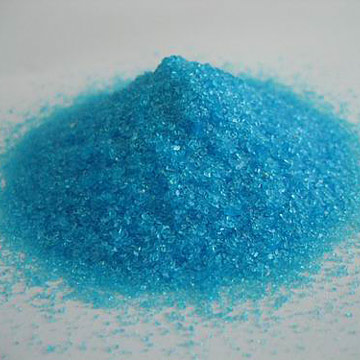I. HYDRATES
1. Some compounds can form lattices that bond to water molecules; without water the compound is often preceded by 'anhydrous'.
Example: Copper Sulfate 2. Those crystals contain water inside them which can be released by heating.
2. Those crystals contain water inside them which can be released by heating.
1. Some compounds can form lattices that bond to water molecules; without water the compound is often preceded by 'anhydrous'.
Example: Copper Sulfate
 2. Those crystals contain water inside them which can be released by heating.
2. Those crystals contain water inside them which can be released by heating.II. NAMING HYDRATES
1. There are three simple steps to naming hydrates:
a. write the name of the chemical formula.
b. add a prefix indicating the number of water molecules.
c. add "hydrate" after the prefix.
Examples:
1. Cu(SO4) 5H2O= Copper (II) Sulfate pentahydrate
2. Li(CLO4) 3H20= Lithium Perchlorate trihydrate
3. Nickel (II) Sulfate hexahydrate=NiSO4 6H20
TABLE OF PREFIXES:
1-mono
2-di
3-tri
4-tetra
5-penta
6-hexa
7-hepta
8-octa
9-nona
10-deca
III. MOLECULAR COMPOUNDS
I couldn't get the video to embed as well...enjoy!
1. they are covalent; 2 or more non metals
2. low melting and boiling points
3. they share (not exchange) electrons
4. elements usually end in -gen
5. 7 molecules are Diatomic
a. 2 of the same elements
b. H2, N2, O2, F2, Cl2, Br2, I2
6. 2 molecules are Polyatomic
a. P4, S8
IV. NAMING MOLECULAR COMPOUNDS
In class we all decided that we knew how to name molecular compounds so we just did a few examples on the board.
1. N2O4= Dinitrogen tetraoxide
2. CS2= Carbon disulfide
3. P4O10=Tetraphosphorous decaoxide
4. Nitrogen trichloride= NCl3
5. Sulphur dibromide= SBr2
6. Dihydrogen oxide= H2O
IUPAC NAME FORMULA
1. Water H2O
2. Hydrogen Peroxide H2O2
3. Ammonia NH3
4. Glucose C6H12O6
5. Sucrose C12H22O11
6. Methane CH4
7. Propane C3H8
8. Octane C8H18
9. Methanol CH3OH
10. Ethanol C2H5OH
11.Ethane C2H6
That is all. Mr. Doktor is the best!
Michelle Haughian
No comments:
Post a Comment